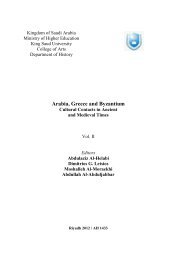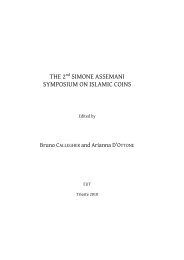ulum-al-quran
ulum-al-quran
ulum-al-quran
You also want an ePaper? Increase the reach of your titles
YUMPU automatically turns print PDFs into web optimized ePapers that Google loves.
52, 67, 69, 70, 78, 79, 82, 84,<br />
There is a difference of opinion as to what was last reve<strong>al</strong>ed in Makka. Some say, following Ibn 'Abbas, that it was Sura<br />
29 (<strong>al</strong>-ankabut); others say Sura 23 (<strong>al</strong>-mu'minun); still others say Sura 83 (<strong>al</strong>-mutaffifin). Some believe that Sura 83 is<br />
actu<strong>al</strong>ly Madinan.<br />
The following 29 suras are, according to Zarkashi, [Zarkashi. Vol. 1, p. 194. For another list see fihrist. 1, pp. 52-3.] of<br />
Madinan origin:<br />
2, 8, 3, 33, 60, 4, 99, 57, 47, 13, 55, 76, 65, 98, 59, 110, 24, 22, 63, 58, 49, 66, 61, 62, 64, 48, 9, 5.<br />
Some hold that Sura 1 (<strong>al</strong>-fatiha) is of Makkan, others that it is of Madinan, origin.<br />
The Makkan suras constitute about 11, and the Madinan about 19 juz' of the text.<br />
From the above division it is obvious that the Madinan suras are the longer ones and comprise a much larger part of the<br />
Qur'an.<br />
Chronology<br />
According to a list based upon Nu'man b. Bashir and given in the fihrist of <strong>al</strong>-Nadim, [Fihrist, I. pp.49-52.] the<br />
chronologic<strong>al</strong> order of the revelation of the suras is as follows:<br />
96, 68, 73, 74, 111, 81, 94, 103, 89, 93, 92, 100, 108, 102, 107, 109, 105, 112, 113, 114, 53, 80, 97, 91,<br />
85, 95, 106, 101, 75, 104, 77, 50, 90, 55, 72, 36, 7, 25, 35, 19, 20, 56, 26, 27, 28, 17, 11, 12, 10, 15,<br />
37, 31, 23, 34, 21, 37, 40, 41, 47, 43, 44, 45, 46, 51, 88, 18, 6, 16, 71, 14, 32, 52, 67, 69, 70, 78, 79,<br />
82, 84, 30, 29, 83, 54, 86.<br />
Why is it important to know the chronology of the suras and verses, <strong>al</strong>though the Qur'an is not arranged in chronologic<strong>al</strong><br />
order<br />
To know the origin and order of some of the revelation is important for understanding its meaning which can often be<br />
more easily grasped if one knows the time and circumstances that relate to it. For instance, many ayat from the Makkan<br />
period may be especi<strong>al</strong>ly meaningful to Muslims living in a strongly un-Islamic environment, while some of the Madinan<br />
period would appe<strong>al</strong> much to Muslims who are in the process of formation of the umma. In some cases, unless one<br />
knows which of two or more related verses was reve<strong>al</strong>ed first, one cannot decide which leg<strong>al</strong> ruling is now binding upon<br />
the Muslims. Here knowledge of the chronology is directly linked with the issue of <strong>al</strong>-nasikh wa <strong>al</strong>-mansukh. [See below<br />
for details.] It is <strong>al</strong>so important to know the chronology of verses in order to understand the gradu<strong>al</strong> development of<br />
many Muslim practices, attitudes and laws such as e.g. towards prohibition of <strong>al</strong>cohol, towards fighting, etc. and to see<br />
how these matters developed historic<strong>al</strong>ly, i.e. during the lifetime of the Prophet in order to understand their full<br />
implications. [For example as far as fighting the enemy is concerned, the first verse reve<strong>al</strong>ed on this particular subject is<br />
from Sura <strong>al</strong>-hajj (22). This verse is from the Madinan period and it becomes clear from this that Muslims were not drawn<br />
to fight against the non-Muslims before the hijra. This has important implications for our own planning and thinking, e.g.<br />
to decide when Islam has to be defended today with verb<strong>al</strong> and when with physic<strong>al</strong> means.]<br />
Knowledge about the Makkan and Madinan suras derived from the sahaba and tabi'un and nothing is said about this by<br />
the Prophet himself. [<strong>al</strong>-Baqillani, in Qattan, op. cit., p.55.] This is because at his time everyone was a witness and well<br />
aware of the occasions of revelation.<br />
Often there is intern<strong>al</strong> evidence, as to which, part of the revelation is Makkan or Madinan. There are a number of guiding<br />
criteria, which help to distinguish between them:<br />
<br />
<br />
<br />
The theme. Does it belong to the Makkan or Madinan period e.g. verses about warfare (9: 5) are only<br />
reve<strong>al</strong>ed after hijra.<br />
Sometimes there is a direct reference, such as e.g. to Abu Lahab in Sura 111, or to the Battle of Badr in<br />
Sura 3: 123.<br />
The length. Makkan ayat are often short, Madinan ones longer, e.g.: Sura <strong>al</strong>-shu'ara'(26) is Makkan. It<br />
has 227 ayat. Sura <strong>al</strong>-anf<strong>al</strong> (8) is Madinan. It has (only) 75 ayat.<br />
Makkan suras are usu<strong>al</strong>ly short, Madinan ones longer, e.g.: Juz' 30 is overwhelmingly Makkan. It has 543 (Makkan) ayat.





